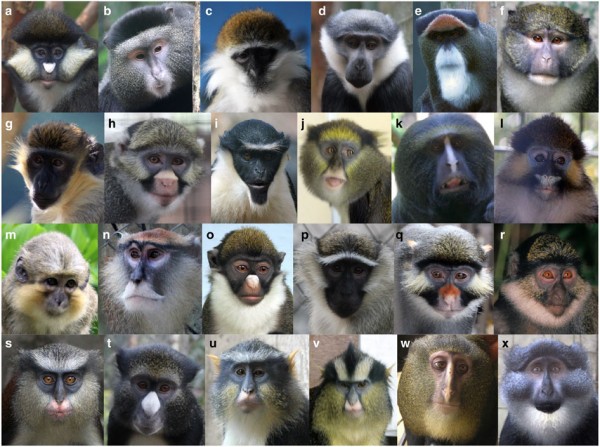Old World Monkeys’ Facial Feats Evolve to Avoid Hybrid
| Erika Villanueva | | Jun 27, 2014 12:58 AM EDT |
(Photo : nature.com) Old World Monkey facial features evolve to become more visually distinct, according to NYU (US) and EU (UK) study.
New York University and University of Exeter's recent study shows that Old World monkeys have undergone significant evolution in appearance to avoid interbreeding with closely related and geographically proximate species.
William Allen and James Higham of NYU and Martin Stevens of the University of Exeter examined 22 unique faces of guenons in their study published on June 26 in the academic journal Nature Communications.
Like Us on Facebook
According to the study, the Cercopithecini primate changed remarkably in their facial features to be able to avoid interbreeding among sympatric species that often travel, feed and sleep side-by-side.
Interbreeding, which may result in afflicted infertile offspring, stays an unwelcome possibility to these guenons-a group of more than two dozen monkeys native to the forests of Central and West Africa.
During the 80s, an Oxford zoologist named Jonathan Kingdon had attempted to explain the reason for the diverse facial appearance of guenons, showing markings such as differently colored eyebrow patches, ear tufts, nose spots and mouth patches. His hypothesis stated that sympatric guenon have undergone these changes to avoid the risks of hybridizing.
To test Kingdon's hypothesis that is merely based on observations with the naked eye, the researchers of this recent study used quantitative analysis through sophisticated methods including facial recognition algorithms that could identify and quantify detailed facial features.
For over 18 months, they collected photographs of nearly two dozen species of guenons in the zoos of the United States and the United Kingdom. They then employed what is known as the eigenface technique, which is used in the field of computer vision for machine recognition of faces, to distinguish primate features then determine whether the appearance of each guenon species was related to others or not.
Researchers then concluded their study from results suggesting that face patterns of guenon species have evolved to become more visually distinct from those sympatric species that they are at risk of hybridizing with.
TagsNew York University, Exeter University, Old World Monkeys, Cercopithecini, interbreeding
©2015 Chinatopix All rights reserved. Do not reproduce without permission
EDITOR'S PICKS
-

Did the Trump administration just announce plans for a trade war with ‘hostile’ China and Russia?
-

US Senate passes Taiwan travel bill slammed by China
-

As Yan Sihong’s family grieves, here are other Chinese students who went missing abroad. Some have never been found
-

Beijing blasts Western critics who ‘smear China’ with the term sharp power
-

China Envoy Seeks to Defuse Tensions With U.S. as a Trade War Brews
-

Singapore's Deputy PM Provides Bitcoin Vote of Confidence Amid China's Blanket Bans
-

China warns investors over risks in overseas virtual currency trading
-

Chinese government most trustworthy: survey
-

Kashima Antlers On Course For Back-To-Back Titles
MOST POPULAR
LATEST NEWS
Zhou Yongkang: China's Former Security Chief Sentenced to Life in Prison

China's former Chief of the Ministry of Public Security, Zhou Yongkang, has been given a life sentence after he was found guilty of abusing his office, bribery and deliberately ... Full Article
TRENDING STORY

China Pork Prices Expected to Stabilize As The Supplies Recover

Elephone P9000 Smartphone is now on Sale on Amazon India

There's a Big Chance Cliffhangers Won't Still Be Resolved When Grey's Anatomy Season 13 Returns

Supreme Court Ruled on Samsung vs Apple Dispute for Patent Infringement

Microsoft Surface Pro 5 Rumors and Release Date: What is the Latest?










